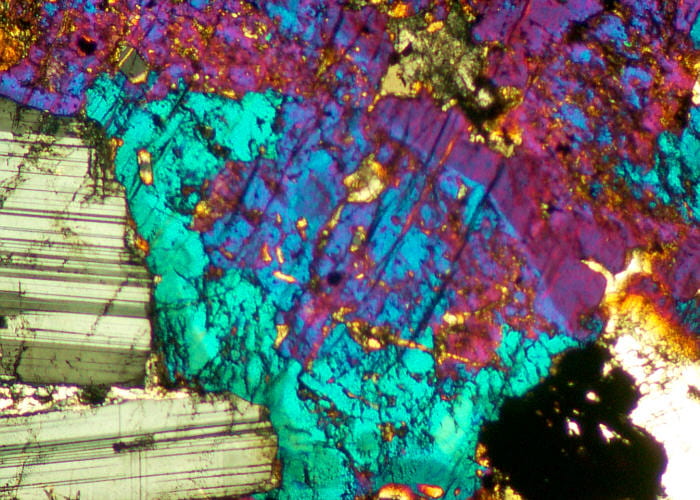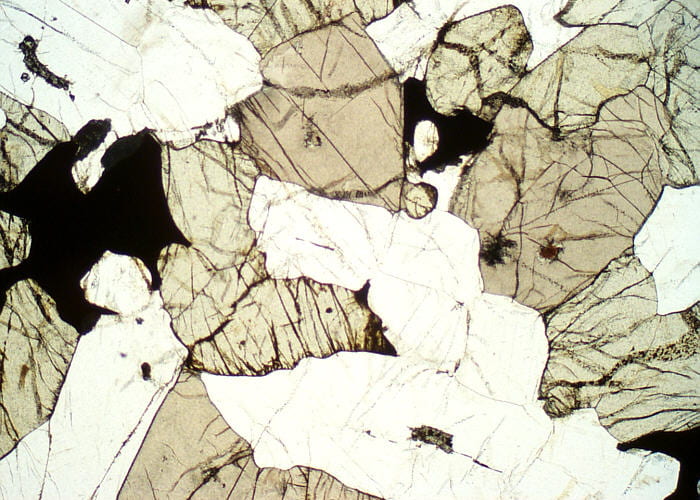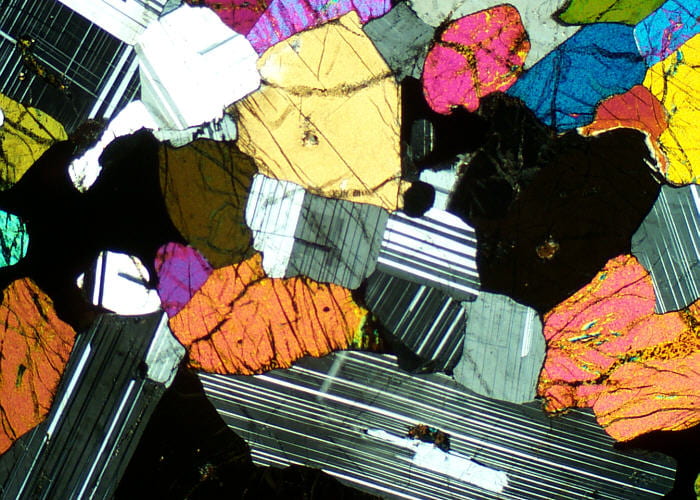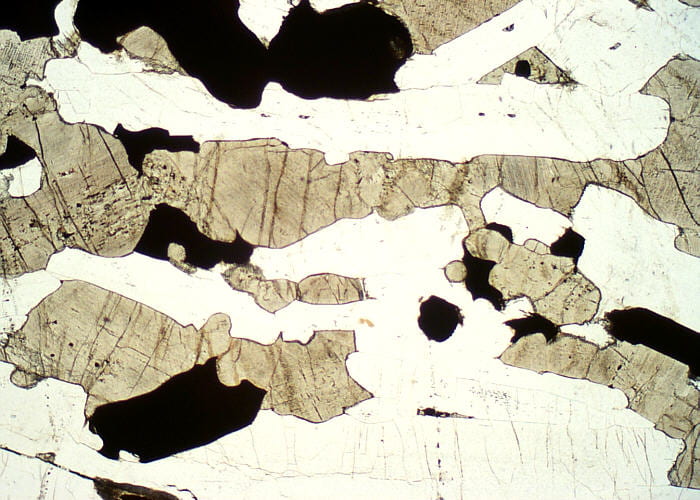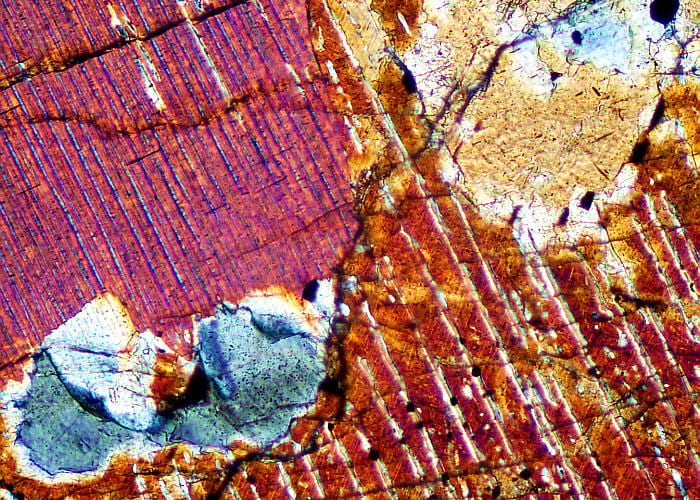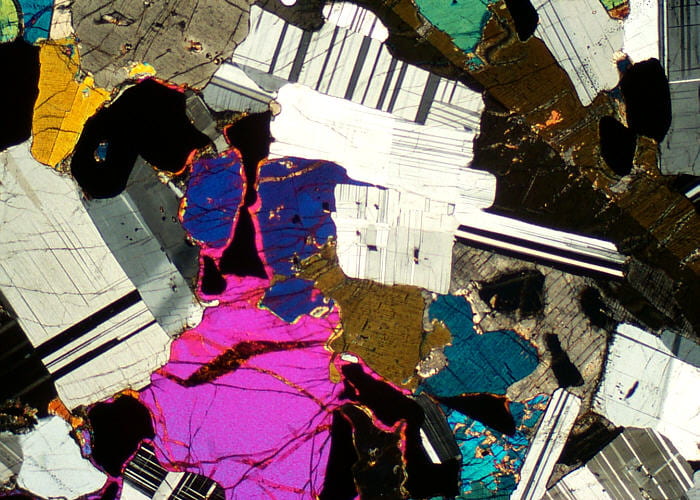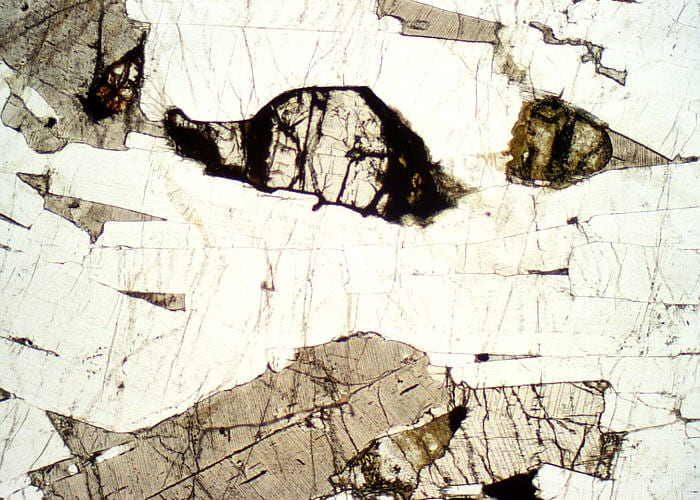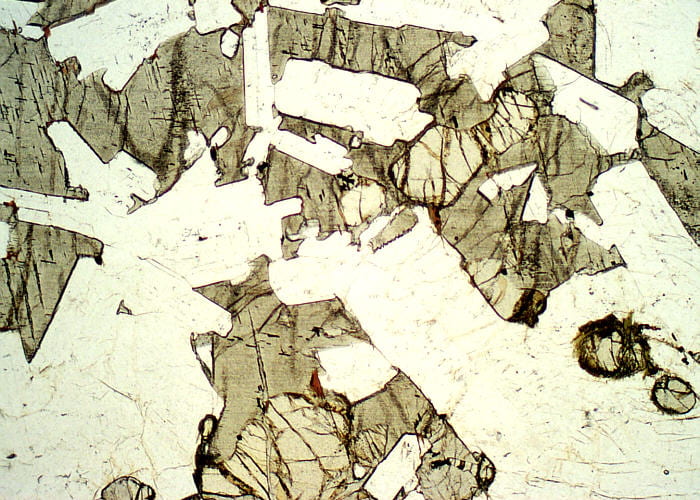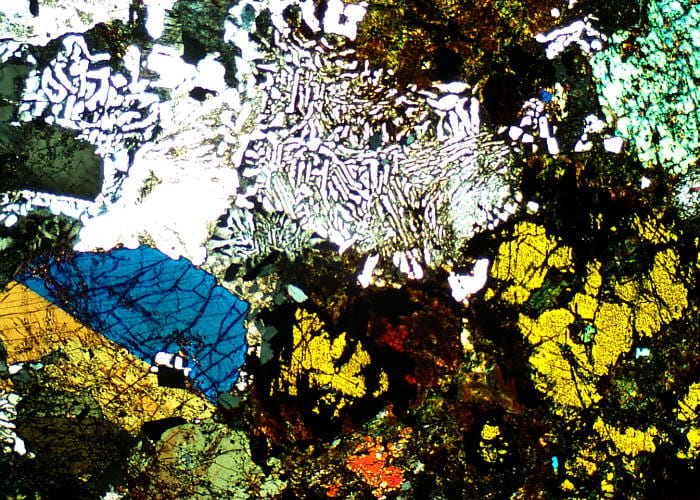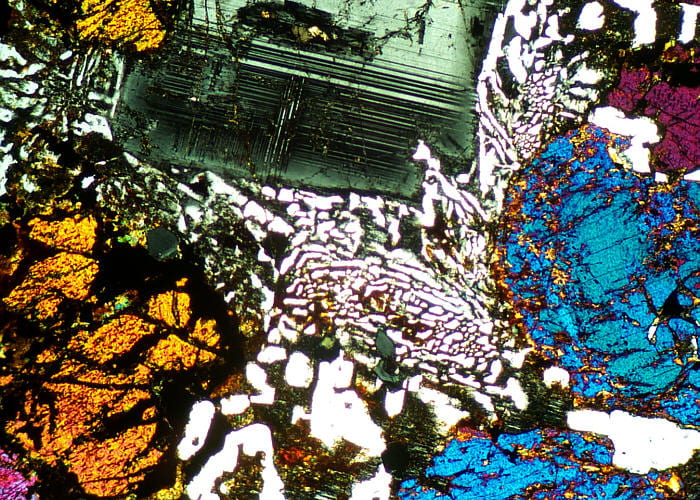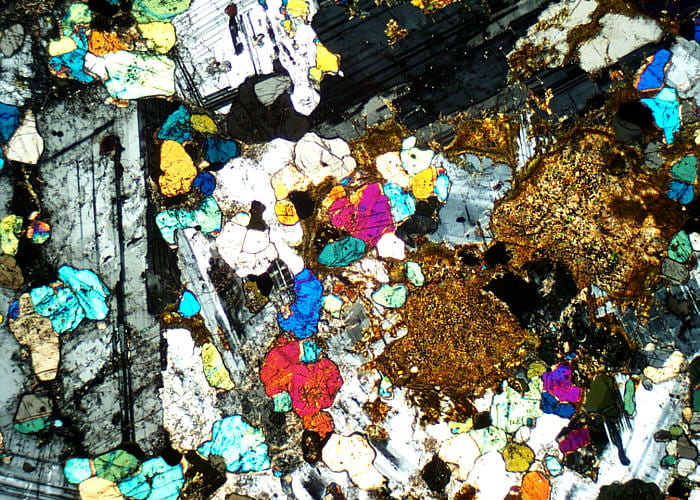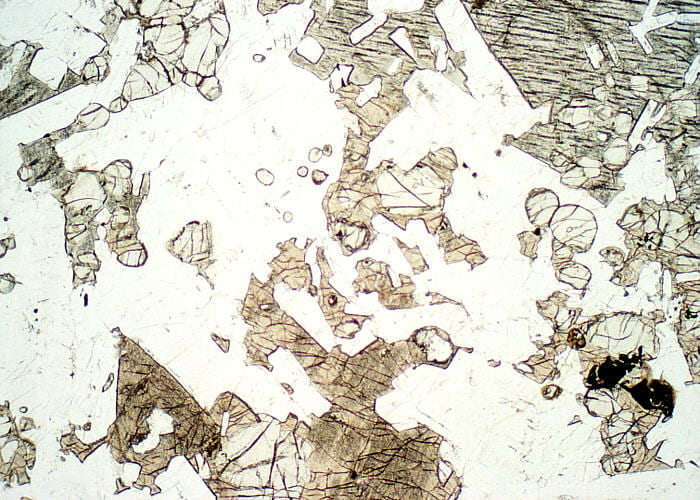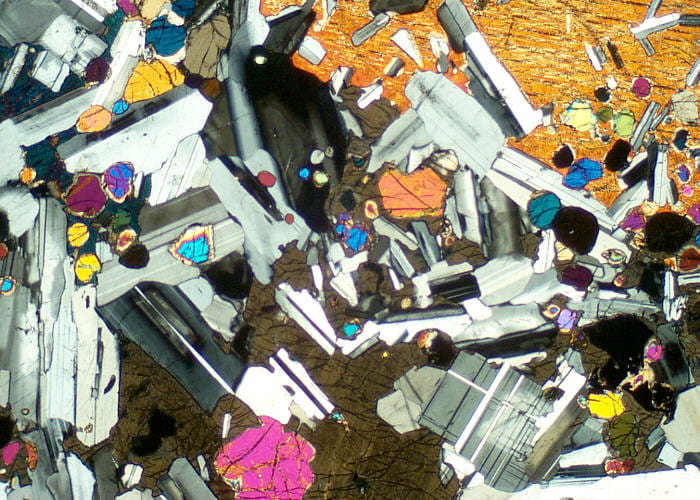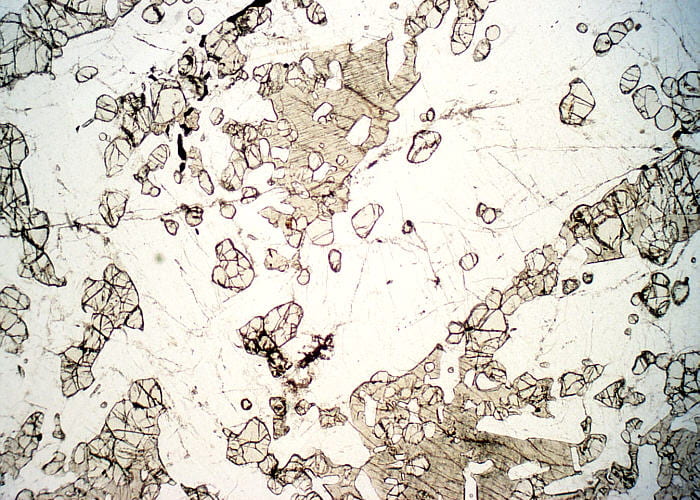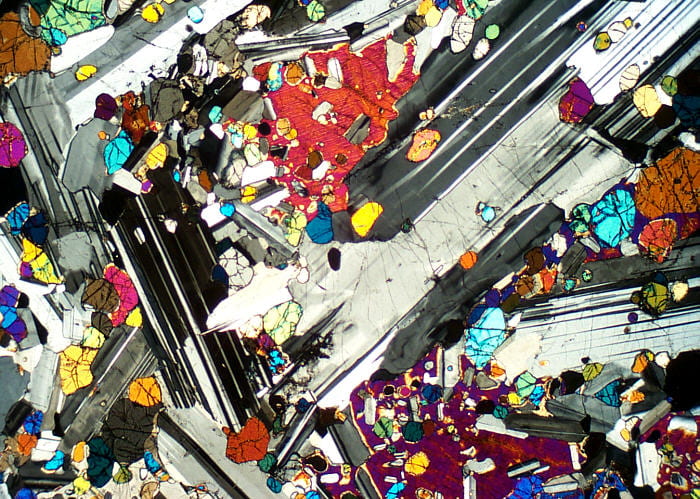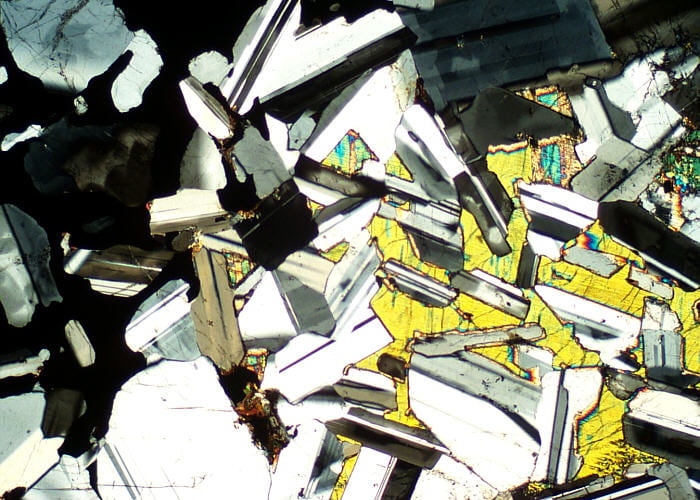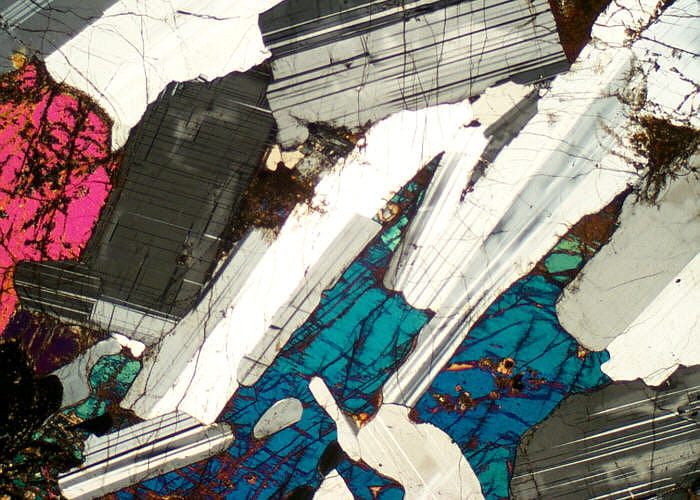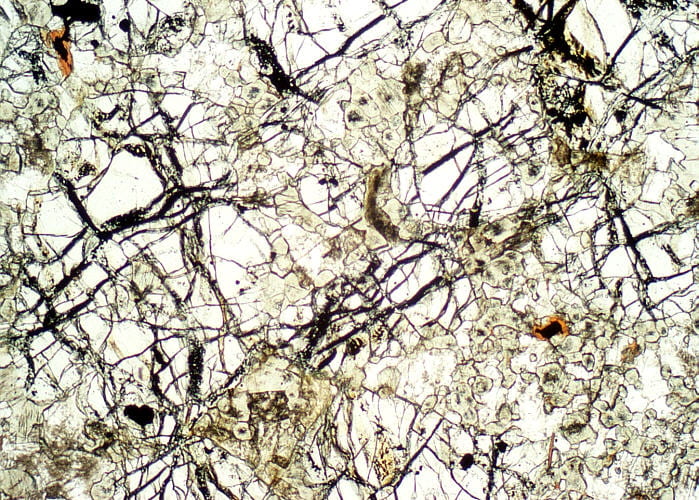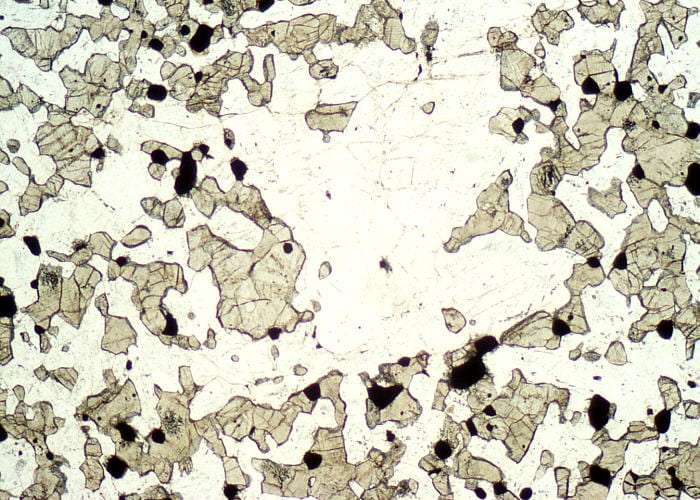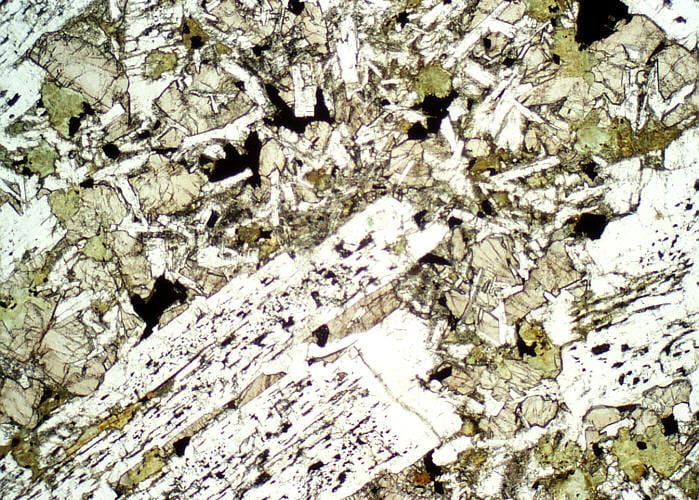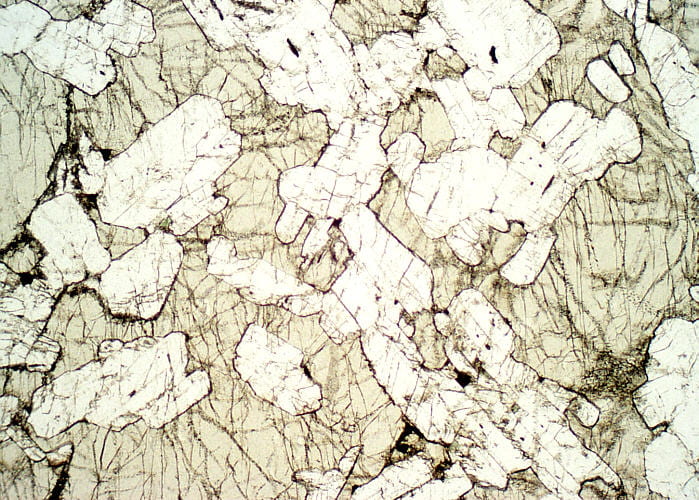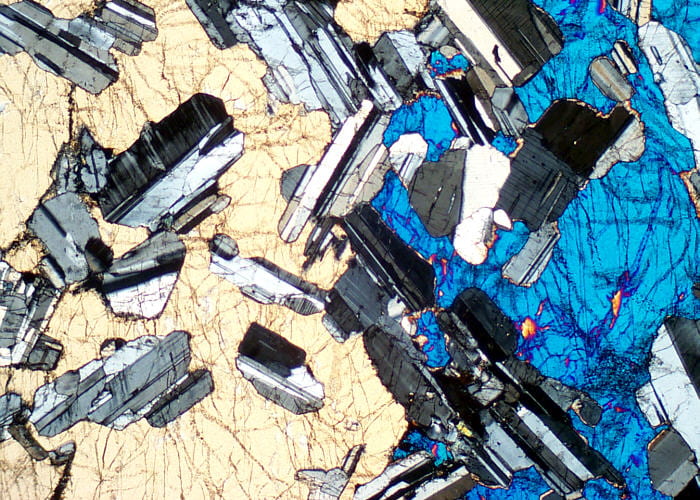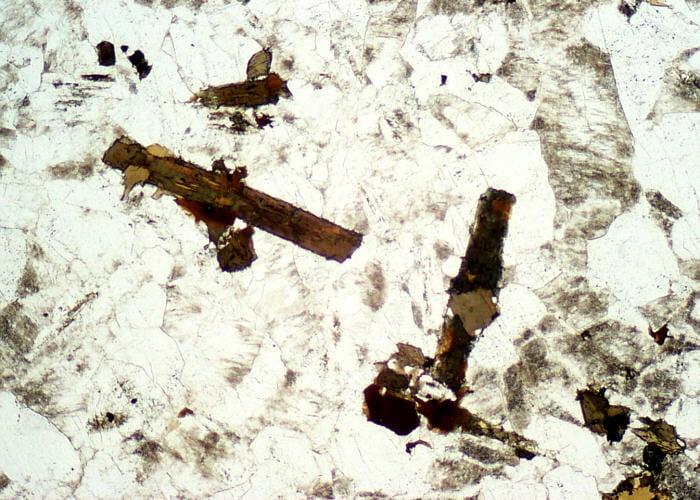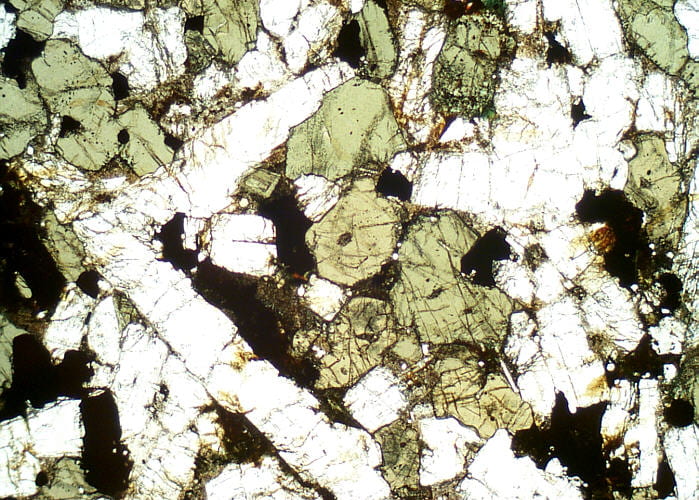These photomicrographs were taken of thin sections from samples I collected while on this trip. The photos here are generally representative, though doubtless my collection had gaps in mineralogy and textures. Most photos show plane-light view, but will show a cross-polarized light view if you click on the arrows visible to either side of the images.
Upper Zone c
|
|
UZc. Mineralogy: plagioclase, olivine, primary augite (brown), augite inverted from ferrobustamite (green), oxides, apatite. Cumulus phases are plagioclase, olivine, ferrobustamite, oxides, augite, and apatite. Olivine has a dark, finely speckled appearance because of small, brown and black oxide plates, probably unmixed from the olivine during subsolidus oxidation. Green augite is generally in crystal cores, and brown augite is on the rims, and are optically continuous. No separate grains of relict ferrobustamite were identified by me. In cross-polarized light, augite cores and rims have slightly different birefringent colors. Olivine birefringence shows through well in the cross-polarized light view. Plane and cross-polarized light views. Field width is 6 mm. |
|
|
UZc. Detail of some of the augite, with strongly contrasting core and rim colors and sharp contacts. The distinction between green augite cores and brown rims is more clear in this view. Birefringence varies but the extinction angles of the brown and green augite are similar. Plane and cross-polarized light views.Field width is 3 mm. |
 |
UZc. Interstitial quartz-bearing granophyre. Cross-polarized light view only. Field width is 1.2 mm. |
Upper Zone b
|
|
UZb. Mineralogy: plagioclase, augite, olivine, oxides, and apatite. Cumulus phases are plagioclase, olivine, augite, oxides, and apatite. This sample is somewhat altered. Though it contains no orthopyroxene or inverted pigeonite, the augite has abundant, very thin pigeonite exsolution lamellae. Olivine crystals are visible at the left-center and bottom-left of the image. Plane and cross-polarized light views. Field width is 6 mm. |
Upper Zone a
|
|
UZa. Mineralogy: plagioclase, augite, olivine, oxides. Cumulus phases are plagioclase, olivine, augite, and oxides. Augite is light brown, and olivines are slightly lighter in color and slightly greenish, and several grains of each are visible. Plane and cross-polarized light views. Field width is 6 mm. |
Middle Zone
|
|
MZ. Mineralogy: plagioclase, augite, inverted pigeonite, and oxides. Cumulus phases are plagioclase, augite, pigeonite, and oxides. Parallel alignment of plagioclase crystals is prominent in this sample. Plane and cross-polarized light views. Field width is 6 mm. |
Lower Zone c
|
|
LZc. Mineralogy: plagioclase, augite, olivine, inverted pigeonite, oxides. Cumulus phases are plagioclase, augite, olivine and oxides. Augite is light brown, olivine is lighter, as is the interstitial inverted pigeonite, which is now mostly orthopyroxene with augite exsolution lamellae. In cross-polarized light, notice interstitial olivine rimming Fe-Ti oxides, optically continuous with cumulus olivine. Plane and cross-polarized light views. Field width is 6 mm. |
Lower Zone b
|
|
LZb. Mineralogy: plagioclase, augite, olivine, inverted pigeonite, and oxides (interstitial only). Cumulus minerals include plagioclase, olivine, and augite. Olivine is just above center, augite crystals are brownish, and inverted pigeonite (probably interstitial) is at the lower right. Plane and cross-polarized light views. Field width is 6 mm. |
Lower Zone a
|
|
LZa. Mineralogy: plagioclase, olivine, augite, inverted pigeonite, oxides. Cumulus phases are plagioclase and olivine. Augite crystals here are clearly interstitial, with lighter-colored olivine crystals. Plane and cross-polarized light views. Field width is 6 mm. |
Sandwich horizon candidates
|
|
Sandwich horizon candidate 1. This is from the south flank of Basistoppen. Mineralogy: plagioclase, olivine, augite (in part inverted ferrobustamite), oxides, and apatite, with abundant interstitial granophyre and subsolidus alteration. Like the UZc sample shown above, the augite here includes brown and green varieties. I think that the green augite, mostly in cores and generally optically continuous with adjacent brown augite, is inverted ferrobustamite. No zircon was seen, though the sandwich horizon is supposed to have up to 1500 ppm Zr. Plane and cross-polarized light views. Field width is 6 mm. |
|
|
Sandwich horizon candidate 1. Same sample as above, showing detail of olivine (lower left) and the brown and green colors in the augite (right). In this image, the brown augite is in the grain core, which is unusual. Perhaps augite nucleated and grew first, and was overgrown by ferrobustamite (now inverted to green augite). Plane and cross-polarized light views. Field width is 3 mm. |
|
|
Sandwich horizon candidate 2. This sample was taken from the east flank of Nunatak 1. Mineralogy: plagioclase, augite, olivine (mostly altered to a mass of serpentine, talc, and magnetite), oxides, apatite. The apatite is not particularly abundant, and no zircon was seen. Again, the sandwich horizon is supposed to have up to 1500 ppm Zr. Plane and cross-polarized light views. Field width is 6 mm. |
Contact Zone, the chilled margin
|
|
Contact Zone. Gabbro ~10 cm from the contact with Archean gneiss on Mellemø Island. Mineralogy: plagioclase, augite, orthopyroxene(!), inverted pigeonite, oxides. Olivine was not found, possibly because of contamination of the border zone by silica-rich liquids derived from the adjacent gneiss. Plane and cross-polarized light views. Field width is 6 mm. |
|
|
Contact Zone. Gabbro taken from between wherlite xenoliths at the base of Uttental Plateau, near Uttental Sund. Mineralogy: plagioclase and olivine with interstitial orthopyroxene, augite, and oxides. This sample is remarkable in having large orthopyroxene crystals and no pigeonite, inverted or otherwise. The orthopyroxene is in the center and lower parts of this image and is pinkish, the augite is mostly at the upper right, and is greenish, and the olivine crystals are all rather round and colorless. Plane and cross-polarized light views. Field width is 6 mm. |
Marginal Border Series
|
|
MBS. “Tranquil zone” sample from the western margin of Uttental Plateau at ~150 m elevation. Mineralogy: plagioclase and olivine with interstitial augite, orthopyroxene, and oxides. Orthopyroxene is the faintly pinkish mineral at the top center and right, augite is the mineral with exsolution lamellae in the center and bottom left, and olivine crystals are scattered throughout. No inverted pigeonite was found. Plane and cross-polarized light views. Field width is 6 mm. |
|
|
MBS. Perpendicular feldspar rock from ~10 m inside the contact on Mellemø Island. Mineralogy: plagioclase, olivine, interstitial augite, and oxides. The largest plagioclase crystal visible here, extending from the picture center into the upper-right corner, is one of the perpendicular feldspars. The scale of the perpendicular feldspars is difficult to see even on the scale of a whole thin section. For other examples, see Irvine et al. (2001, Figure 47). Plane and cross-polarized light views. Field width is 6 mm. |
Replacement gabbroic anorthosite
|
|
Replacement gabbroic anorthosite. This sample is from the crossbedded belt, LZa, on Uttental Plateau. Mineralogy: plagioclase appears to be cumulus, like the plagioclase elsewhere in the pluton. All other phases (augite, minor inverted pigeonite, and oxides) appear to be interstitial. I wonder if this replacement gabbroic anorthosite isn’t basically a framework of the original rock with some mafic minerals dissolved out and more plagioclase precipitated in by migrating plagioclase-rich residual liquids. Plane and cross-polarized light views. Field width is 6 mm. |
Autolith blocks
|
|
Autolith block. Gabbroic anorthosite from a small autolith block in the Homestead area, UZa. Mineralogy: plagioclase with interstitial augite, olivine, oxides, and biotite. Interstitial olivine is on the right, augite is on the left. Plane and cross-polarized light views. Field width is 6 mm. |
 |
Autolith block. Same sample as immediately above, showing rare interstitial quartz. Cross-polarized light view only. Field width is 3 mm. |
|
|
Autolith block. Gabbroic anorthosite from a medium size autolith from the Homestead area, UZa. Mineralogy: cumulus plagioclase and olivine with interstitial augite, oxides, and biotite. Olivine is on the left, augite is on the bottom of the image. Plane and cross-polarized light views. Field width is 6 mm. |
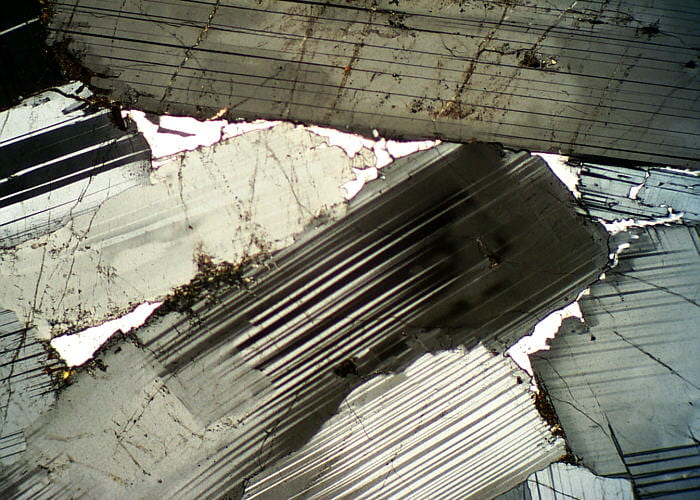 |
Autolith block. Same sample as that immediately above, showing interstitial quartz. Cross-polarized light view only. Field width is 3 mm. |
|
|
Autolith block. Gabbro autolith from the giant block on the east end of Kraemer Island on the shore of Uttental Sund, in the MZ. Mineralogy: plagioclase, augite, inverted pigeonite, and oxides. No olivine was seen, so this rock is mineralogically equivalent to the MZ (roof facies called UBZβ). Plane and cross-polarized light views. Field width is 6 mm. |
Wherlite xenoliths in the Marginal Border Series
|
|
Wherlite xenoliths. This sample is from the contact zone on the lower flanks of Uttental Plateau. Mineralogy: olivine, augite, orthopyroxene, plagioclase, oxides. In this image the olivines are colorless with black magnetite–serpentine fractures running through them. Augite and orthopyroxene are both slightly brown and difficult to distinguish from one another. Plane and cross-polarized light views. Field width is 6 mm. |
Basalt xenoliths in the Layered Series
|
|
Basalt xenolith. Olivine-free xenolith from the MZ of southeast Kraemer Island. Mineralogy: plagioclase, augite, inverted pigeonite, and oxides. The texture has been annealed so that it is much more granulitic than is typical of basalts. No olivine was seen in this sample. Plane and cross-polarized light views. Field width is 3 mm. |
|
|
Basalt xenolith. Olivine-rich xenolith from the MZ of southeastern Kraemer Island. Mineralogy: plagioclase, augite, olivine, and oxides. This sample also has a granulitic texture. Because this sample is so olivine-rich, it may be from the section of picrite flows into which the Skaergaard intruded. In this image olivine is slightly lighter in color than the augite. No pigeonite was seen in this sample. Plane and cross-polarized light views. Field width is 6 mm. |
Basalt dikes
|
|
Basalt dike. The plagioclase porphyry dike that is one of the oldest in the Skaergard Homestead area, based on crosscutting relationships. Mineralogy: plagioclase, augite, oxides, and greenish altered material that was probably glass or fine-grained interstitial segregations. No olivine was seen in this rock, nor altered material that was obviously pseudomorphing olivine. Plane and cross-polarized light views. Field width is 6 mm. |
|
|
Basalt dike. Campsite composite dike chilled margin from the Homestead area, from which the xenolith sample below was taken. Mineralogy: phenocrysts of plagioclase, olivine, and augite. The matrix is made of plagioclase, augite, and oxides without olivine. Compared to other samples, this is astonishingly fresh rock. Plane and cross-polarized light views. Field width is 6 mm. |
Xenolith in basalt dike
|
|
Xenolith in basalt dike. Gabbro xenolith in the Campsite composite dike. It was difficult to tell the size of the xenolith sampled, but it was at least 2 m across. Mineralogy: plagioclase with interstitial augite. No olivine was seen, nor oxides except those associated with patches of alteration. One interstitial pyroxene was unidentifiable because it was completely and selectively altered, and I suspect that it was orthopyroxene or inverted pigeonite. Plane and cross-polarized light views. Field width is 6 mm. |
Granophyre
|
|
Transgressive granophyre dike. This sample was taken from the northern end of the Homestead area, near Trough B. Mineralogy: orthoclase perthite, plagioclase, quartz, brown hornblende, brown biotite, apatite, and oxides. There is no apparent flow foliation even though the dike is was only ~8 cm across. There is moderate alteration throughout. Plane and cross-polarized light views. Field width is 6 mm. |
|
|
Interstitial granophyre. This sample is from sandwich horizon candidate 1, also seen above. This granophyre that is completely unrelated to the transgressive granophyre. It represents residual granitoid liquid produced by in situ fractional crystallization, or something close to that concept. Granophyre of this sort characteristically has graphic intergrowth patterns. Rock mineralogy: quartz, orthoclase, plagioclase, olivine, augite, oxides, and apatite, with abundant interstitial granophyre and subsolidus alteration. Plane and cross-polarized light views. Field width is 6 mm. |
Basistoppen Sheet
|
|
Basistoppen Sheet. This sample came from gray-weathering rock at the south end of Nunatak 1, mapped in McBirney (1989) as Basistoppen. Its gray color contrasts sharply with the mostly brown-weathering Skaergaard rocks. Mineralogy: plagioclase, augite, olivine, oxides, and apatite. In several respects this rock looks much like the more evolved parts of the Skaergaard: dark olivines are full of oxide inclusions. There is moderate alteration. The augite grains are greenish, rather than brown as they are everywhere in the Skaergaard except some in UZc (probably inverted ferrobustamite). Plane and cross-polarized light views. Field width is 6 mm. |
|
|
Basistoppen Sheet. Interstitial granophyre in the Basistoppen sample with central quartz. The high birefringence grain just below and to the left of center looks like zircon. It is the only zircon grain I saw in any of the mafic rocks in my Skaergaard sample set. Plane and cross-polarized light views. Field width is 1.2 mm. |



